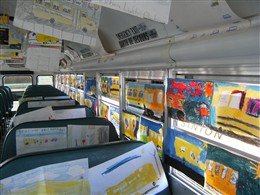
Children are not the only ones who should be reminded about school bus safety. Teaching the school bus safety rules to parents, guardians, caregivers, teachers, principals, and motorists is an important contributor to the safety and personal security of the children who ride the bus to school and home. Injuries and fatalities, which are very rare, happen more often outside the school bus as students are boarding and leaving the bus or crossing the street. Education and awareness about the correct way to enter and exit the bus, cross the street and to stay away from the “danger zone” is crucial to child safety.
Information for Riders, Parents and Motorists
School Bus Rider Safety Training Program
The School Bus Rider Safety Training Program was developed by OECM in partnership with Intertrain Incorporated, input from the Ontario Association of School Business Officials (OASBO) Transportation Committee and School Bus Ontario (SBO) and funding from the Province of Ontario. The program was created to help standardize school bus rider safety training in Ontario. The School Bus Rider Safety Training Program includes training materials, videos, modules and toolkits designed to teach students from kindergarten to Grade 8 about school bus safety rules.
The program can be accessed online at www.schoolbusridersafety.ca.
School Bus Safety Rules
In Ontario, there are more than 18,000 school buses travelling 2 million kilometres on a typical school day. School bus drivers follow specific instructions to load and unload passengers. This is one of the most important responsibilities of the driver as most incidents occur outside the bus.
We ask everyone to stay safe by remembering these rules:

When you board or leave a bus
• Be at the bus stop before the bus comes.
• Wait in a safe place well back from the edge of the road – don’t play in ditches or on snow banks.
• Stay out of the DANGER ZONE. If you can touch the bus, you’re too close. Use 10 giants steps to take you out of the DANGER ZONE, and make sure you and the bus driver can see each other.
• Always cross the road in front of the bus, never behind.
• Look all ways and wait for the driver to signal before you cross in front of a bus.
• Walk at least 10 big steps from the front of the bus.
• Enter or exit the bus in single file. Never push or shove.
• Walk – never run – across the road.
• NEVER stop to pick up anything that you may have dropped in the DANGER ZONE. Ask an adult or the bus driver to help.
While on the bus
• Find a seat right away. Stay seated, facing forward at all times.
• Don’t put things in the aisle.
• Never distract the bus driver. Always follow his or her instructions.
• Don’t eat or drink.
• Don’t yell, push people or throw things.
• Keep your arms and head inside the bus.
Crossing the road:
- Always look around; the bus driver is also watching you and will honk if there is any danger
- Always cross the road in front of the bus, never behind
- Take at least 10 giant steps in front of the bus
- Pass the crossing arm; stop and look at the driver to give you the signal to cross
- The driver will hold up their hand; this means wait until the next signal is given
- When it is safe to cross, the driver will change his hand signal to an open hand with a thumbs up
- If it is not safe to cross, the driver will honk the horn with one hand while holding the other hand up
- Walk, never run across the road
First Rider Programs
If you know the name of the school bus company in the area that transports to your child’s school, feel free to contact them directly and ask if they provide a “first-timer” briefing or similar program. Where should parents begin when preparing their child to ride the school bus for the first time? Contact the school board in your area. The school board is responsible for bussing children to school and home and can advise you of any programs that they provide, or that the school bus company may provide to help with first-time school bus riders.
First Rider Programs are frequently organized by the school bus company providing service to a school. These programs familiarize very young first time riders, parents and guardians about school bus safety. Children are taught how to get on and off the bus safely while parents and guardians are reminded to make sure their child(ren) know what to do if for example, they miss the bus or get off at the wrong stop. This program reviews the school bus safety rules and provides the opportunity to ask questions.
Contact your local transportation provider or school board to find out when a First Rider Program is offered in your area: http://www.edu.gov.on.ca/eng/sbinfo/
During School Bus Safety Week, bus operators, school boards and transportation consortia organize events and activities to remind everyone to watch for children crossing the street, especially before and after school. This is an excellent opportunity for safety awareness and community partnerships. School Bus Safety Week is an annual event during the third week of October.
School Safety Patrollers
School Safety Patrol programs protect school children by employing safe street-crossing practices and educating motorists on the illegal passing of a school bus. Safety patrollers are student volunteers who have been trained by local police services to use potentially life-saving skills while on duty. Patrollers learn how to react in life-threatening situations and manage multiple students at the same time.
The Canadian Automobile Association (CAA) developed the School Safety Patrol program almost 80 years ago. Student volunteers operate in more than 800 elementary schools in Ontario. To start a program in your area, simply contact the community service officer of your local police service and ask about implementing the program or contact CAA for more information. More information on the CAA program and contact information is available on their website at: CAA School Safety Patrol
For more information about student safety visit the links below:
School Bus Safety – Information for Riders, Parents, and Motorists
School Bus Rider Safety Training Program
